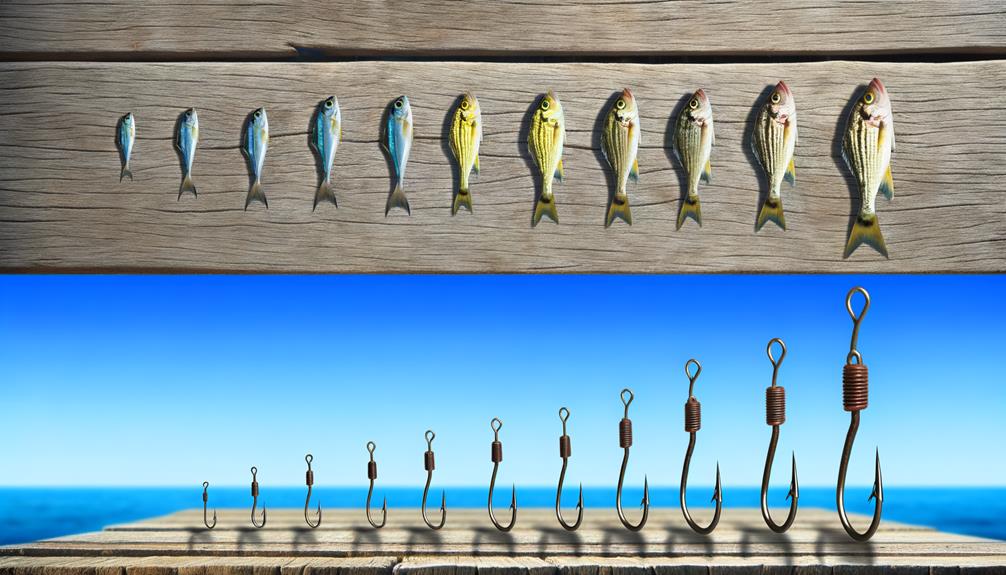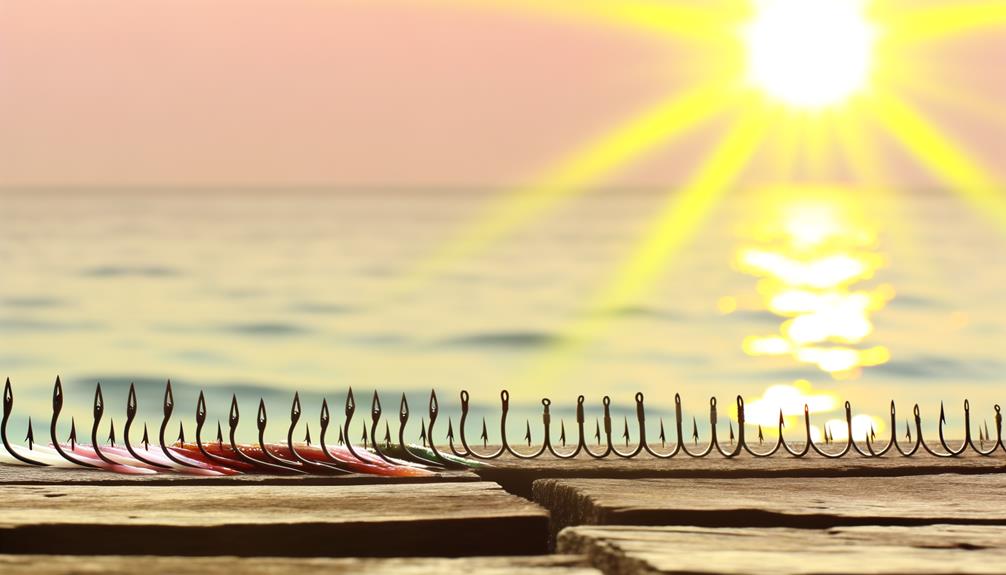Selecting the appropriate hook size for saltwater pier fishing can significantly impact the success of your fishing excursions. The size of the hook should correspond with both the bait being used and the size of the fish you're aiming to catch.
Indeed, the variety of species in saltwater environments necessitates a more nuanced approach to hook size selection. This crucial decision hinges on several factors, including the type of fish targeted, the local marine environment, and even the time of year.
As you continue to explore this topic, you may find that a more successful pier fishing experience is just a well-chosen hook away.
Key Takeaways
- Saltwater pier fishing requires hook sizes ranging from 2/0 to 4/0, preferably coated for durability.
- For targeting larger species like drum or snook, opt for larger hooks, while smaller ones are ideal for whiting and pinfish.
- Stainless steel, Duratin-coated, and tinned hooks can withstand the corrosive saltwater environment.
- Maintenance, including regular sharpness checks and rust prevention, ensures hook longevity and effectiveness.
Understanding Hook Sizes
Delving into the nuances of hook sizes is essential for successful saltwater pier fishing, as these sizes, typically ranging from 1/0 to 6/0, play a crucial role in bait presentation and fish targeting. The size of your hook correlates directly with the size of the live bait you're using and the fish species you're targeting. Smaller hook sizes such as 1/0 are suitable for smaller baits and fish species, creating an enticing morsel for less sizable prey.
On the other hand, those larger, more aggressive fish species often require larger bait and thus, a larger hook size such as the 6/0. This is not simply a matter of physically accommodating the bait. A larger hook size can also withstand the brute force of a larger fish, ensuring your catch won't escape due to a broken hook.
Careful consideration of the target fish species, bait size, and pier conditions is paramount when selecting the appropriate hook size. By matching the hook size to the bait size, you can ensure a proper presentation, increasing your chances of hooking the desired fish. Experimentation and observation can further fine-tune your hook size selection, fostering a deeper connection with the art of saltwater pier fishing.
Essential Hook Sizes for Beginners
When embarking on the journey of saltwater pier fishing, beginners should pay close attention to hook sizes. The sizes 1/0 through 3/0 offer a good range, accommodating the capture of both smaller species like panfish and larger ones such as grouper.
The selection of the right hook size is pivotal in ensuring a successful fishing experience, aligning with the species and size of the fish targeted.
Understanding Hook Sizes
For beginners venturing into saltwater pier fishing, comprehending hook sizes is a fundamental aspect of the sport, with sizes typically ranging from 2/0 to 6/0 for targeting medium to large fish species. When fishing live bait off a pier, the bait's size and the target species play significant roles in determining the appropriate hook size.
Here's a simplified guide:
| Hook Size | Ideal for | Target Species |
|---|---|---|
| 2/0 | General Pier Fishing | Various medium-sized species |
| 3/0 | Larger live bait | Bass, Redfish |
| 4/0 | Bigger bait | Groupers, Snappers |
| 5/0 | Large live bait | Large Snappers, Cobia |
| 6/0 | Extra-large bait | Sharks, Large Groupers |
Hook Sizes for Beginners
While understanding the full range of hook sizes is important, newcomers to saltwater pier fishing can initially focus on essential sizes, specifically ranging from 1/0 to 4/0, to effectively target a variety of common fish species.
The larger 4/0 hooks are suitable for bigger, hard-fighting species like snook or redfish, offering the strength needed to reel them in. Conversely, the smaller 1/0 hooks are ideal for catching petite, agile fish like pompano or whiting.
Circle hooks, specifically, can be a good choice for beginners due to their design that hooks fish in the corner of the mouth, reducing the likelihood of gut-hooking. As part of the fishing community, beginners should experiment with these sizes and adapt as they gain experience and knowledge.
Selecting Saltwater Pier Hooks
In the realm of saltwater pier fishing, it is highly recommended for novices to start with hook sizes ranging from 2/0 to 4/0, offering a versatile selection for targeting a myriad of species such as pompano, drum, and Spanish mackerel. These hooks, often coated with corrosion-resistant materials like stainless steel or nickel, provide durability in saltwater environments.
For those who aspire to catch big fish, hooks sized from 5/0 to 8/0 are ideal for larger species like cobia or kingfish. It's crucial to match the hook size with the bait size and targeted fish species to increase the chance of a successful catch.
For catch-and-release fishing, circle hooks are preferred, ensuring a higher survival rate for released fish.
Popular Saltwater Pier Fishing Species
Among the myriad of species targeted by anglers in saltwater pier fishing, snook, redfish, trout, pompano, and sheepshead are particularly popular, especially along the eastern coast of Florida. These species are well-known for their fighting spirit and the culinary delight they offer, making them a favorite among both novice and experienced anglers.
To successfully land these species, it's essential to understand their specific preferences for bait, depth, and structure found near piers. Here is a brief overview:
- Snook: These predators often lurk around structure and prefer live bait presented with a well-balanced rod and reel.
- Redfish: They frequent the bottom and are attracted to cut bait.
- Trout: Trout prefer shallow depths and can be enticed with live bait or lures.
- Pompano and Sheepshead: Both species are bottom feeders, with pompano favoring sandy areas and sheepshead often found near pilings.
Understanding the feeding habits and behavior of these species can significantly improve your saltwater pier fishing success. Armed with this knowledge, your connection with the vibrant community of saltwater pier anglers will only deepen.
Hook Sizes for Different Species

Selecting the appropriate hook size is crucial in saltwater pier fishing, and it varies with the species targeted – larger hooks for species like drum, snook, and redfish, medium-sized hooks for fish such as sheepshead, pompano, and flounder, and smaller hooks for species like whiting, croaker, and pinfish.
When aiming to catch fish like drum, snook, or redfish, consider using hooks of size 1/0 to 3/0. These larger hooks are designed to manage the strength and size of such species. For medium-sized targets like sheepshead, pompano, or flounder, a hook size of 4 to 2 is typically recommended. These hooks are large enough to secure the fish, yet small enough to not deter a bite. For smaller species such as whiting, croaker, or pinfish, hooks of size 6 to 4 are ideal, as they accommodate the smaller mouth sizes of these species.
Importantly, match hook size to bait size. This ensures a natural presentation, improving your hook-up ratio. Also, remember to consult local regulations as they may stipulate specific hook size requirements for certain species or locations. Knowledge of these guidelines will aid in your efforts to responsibly and effectively catch fish.
Choosing the Right Material for Hooks
While the correct hook size is a vital aspect of successful saltwater pier fishing, equally important is the material of the hook, which must be sturdy, durable, and resistant to the corrosive marine environment. A poorly selected hook material can deteriorate swiftly, leading to lost catches when a larger fish takes the bait.
Choosing the right material for your hook can significantly improve your saltwater pier fishing experience. Here are some top materials to consider:
- Stainless Steel: These hooks offer exceptional corrosion resistance, making them a top choice for the harsh marine environment.
- High Carbon Steel: Known for their strength and durability, these hooks are ideal when targeting larger saltwater species.
- Duratin-Coated: Mustad's Duratin-coated hooks provide additional protection against rust and corrosion, extending the hook's lifespan in saltwater conditions.
- Nickel-Plated: Offering a balance between corrosion resistance and affordability, these hooks are ideal for those starting out in saltwater pier fishing.
Importance of Hook Sharpness

In the realm of saltwater pier fishing, the sharpness of your hook plays a pivotal role in determining the success of your fishing expedition. A well-maintained, sharp hook dramatically increases your hook-up ratios, giving you the edge in any fishing situation. A dull hook, on the other hand, can result in missed strikes and lost opportunities to land that big catch.
The primary reason to always keep your hooks sharp lies in ensuring a successful pier fishing outing. A sharp hook is crucial for penetrating the tough mouths of many saltwater species. If the hook is not sharp enough, it may simply bounce off, leaving you empty-handed and the fish unharmed.
To make sure your hooks remain in optimal condition, it's essential to check their sharpness regularly. This can be done by gently running your fingernail along the point of the hook. If it slides without digging in, it's time to sharpen the hook. A simple file or hook sharpener can be used to maintain that critical sharpness. This attention to detail and consistent upkeep of your gear will undoubtedly elevate your fishing experience.
Maintaining and Replacing Your Hooks
Beyond ensuring the sharpness of your hooks, regular inspection and maintenance is crucial to uphold their performance in saltwater pier fishing. As you become part of the fishing community, understanding the importance of this routine can make a significant difference in your catches.
- Regularly inspect your hooks for signs of rust, damage, or dullness. Even high-quality hooks like Eagle Claw may lose their edge with continuous use.
- If hooks show signs of wear or corrosion, replace them immediately. A weak hook can cost you a prized catch.
- Use a hook sharpening tool to maintain the sharpness of your hooks. This will improve hook penetration, especially when using live bait like sand fleas.
- Store your hooks in a dry, rust-free environment. Proper storage prolongs their lifespan and maintains effectiveness.
Consider upgrading to corrosion-resistant hooks for increased durability in saltwater environments. This simple change can enhance your fishing experience and bring you closer to the community of seasoned anglers. Remember, maintenance and replacement are as vital as selecting the right hook size in saltwater pier fishing.
Frequently Asked Questions
What Size Hook Is Best for Pier Fishing?
The ideal hook size for pier fishing largely depends on the target species. However, sizes 1 to 2/0 are generally suitable. Ensure hook durability for larger catches and always adhere to pier fishing regulations.
What Size Hooks Should You Use for Saltwater Fishing?
In saltwater tackle selection, it's essential to use size 1 to 3/0 hooks depending on the target species. Hook durability factors, such as strength and resistance to corrosion, also play a significant role in successful saltwater fishing.
What Is the Best Bait for Saltwater Pier Fishing?
The best bait for saltwater pier fishing varies seasonally and includes live shrimp, squid, and mullet. Proper bait preservation techniques enhance effectiveness. Always consider the target species' preferences and local water conditions for optimal bait selection.
What Is the Best Rig for Pier Fishing?
The optimal rig for pier fishing ensures durability and excellent casting. A two-hook dropper rig is ideal for various species, while a trolley rig is recommended for larger fish in deeper waters.
Conclusion
In conclusion, the selection of the appropriate hook size for saltwater pier fishing is a complex process that requires understanding of:
- Hook sizes
- Targeted species
- Bait choice
It is also vital to consider hook material and sharpness for effective fishing.
Regular maintenance and timely replacement of hooks will ensure a successful fishing experience.
Understanding this theory can significantly enhance the angler's capability to make informed decisions and improve their overall fishing prowess.


